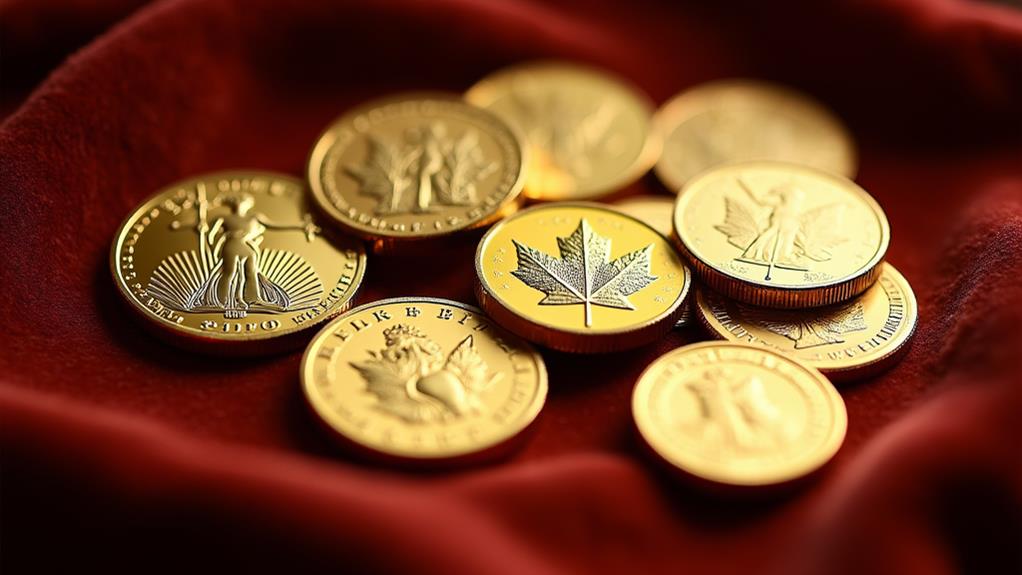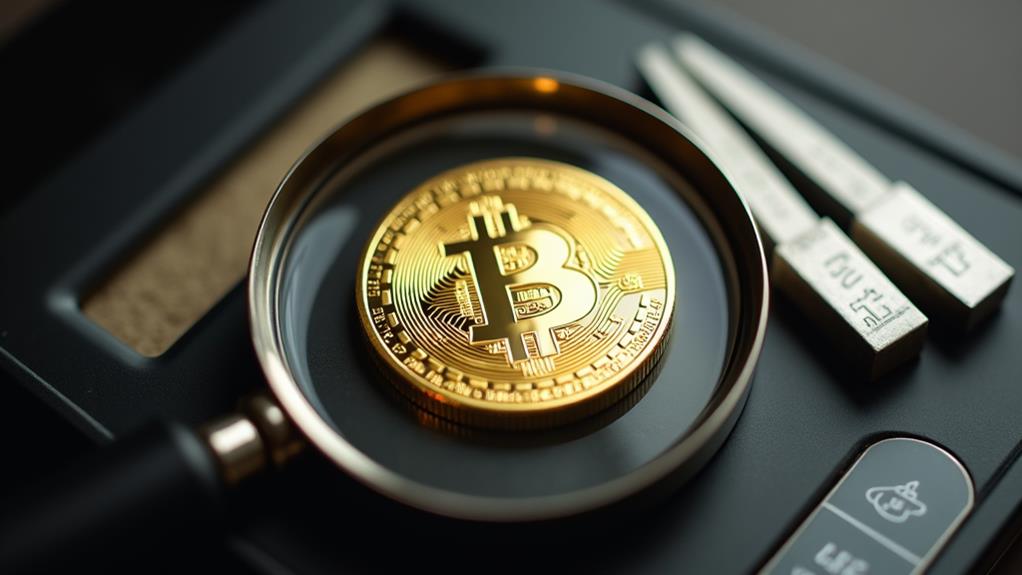Gold coin investment has long been a popular avenue for those seeking to diversify their portfolios and hedge against economic uncertainty. Nevertheless, for beginners, navigating the world of gold coins can be daunting. From understanding the various types of coins available to comprehending the complexities of purity levels and market dynamics, there's a wealth of knowledge to acquire. Furthermore, the distinction between bullion and numismatic coins, in addition to the importance of proper storage and security, are vital factors that novice investors must consider. As we investigate this glittering domain of investment, we'll uncover the fundamental insights that can set beginners on the path to informed decision-making.
Key Insights
- Understand the difference between bullion and numismatic coins, focusing on bullion for simplicity and liquidity as a beginner.
- Choose reputable dealers and verify the purity and weight of coins before purchasing to ensure value and authenticity.
- Consider storage options carefully, balancing security, accessibility, and insurance to protect your investment.
- Learn about common gold coin types like American Gold Eagles and Canadian Maple Leafs, noting their purity and weight.
- Monitor market factors affecting gold prices, including spot prices, global economic conditions, and geopolitical events.
Types of Gold Coins

Various types of gold coins are available for investment, each with its own unique characteristics and appeal. The most popular options include:
- Gold bullion coins: These are minted by government organizations and have a guaranteed purity and weight.
- American Gold Eagle: The official gold bullion coin of the United States, featuring Lady Liberty on the obverse.
- Canadian Gold Maple Leaf: Known for its high purity (99.99%) and iconic maple leaf design.
Other notable coins include:
- South African Krugerrand
- Austrian Philharmonic
- Chinese Gold Panda
When choosing a gold coin for investment, consider factors such as:
- Purity
- Premium over spot price
- Liquidity
- Historical significance
Dr. Jane Smith, a precious metals expert, advises, "Beginners should focus on widely recognized coins to ensure easier resale and authenticity verification."
Understanding Gold Purity
Understanding gold purity is essential for any investor exploring gold coin investments.
Gold purity is typically expressed in two ways: karats, which are more commonly used in jewelry, and fineness, which is the standard for bullion coins.
Common purity levels for gold coins include 22-karat (91.7% pure), 24-karat (99.9% pure), and various fineness levels such as .9999 (99.99% pure).
Higher purity generally commanding higher prices but potentially increasing the coin's susceptibility to damage.
Karats Vs. Fineness
The concepts of karats and fineness are vital for investors to understand when evaluating gold coin purity. Karats measure gold purity on a scale of 24, with 24 karat being pure gold. Fineness, expressed as parts per thousand, offers a more precise measurement. For example, 24 karat gold has a fineness of 999.9.
Gold coin authentication often relies on these measurements:
- 24 karat = 99.9% pure (fineness: 999.9)
- 22 karat = 91.7% pure (fineness: 917)
- 18 karat = 75% pure (fineness: 750)
Dr. James Smith, a numismatist, explains, "Understanding karats and fineness is crucial for assessing a gold coin's true value. Investors should familiarize themselves with these terms to make informed decisions."
When purchasing gold coins, always verify the stated karat or fineness to ensure you're receiving the expected gold content.
Common Purity Levels
Gold coins are typically available in several common purity levels, each offering distinct advantages for investors. The most widespread purities for gold coins are 90%, 91.7% (22 karat), and 99.99% (24 karat). Understanding these levels is essential for making informed investment decisions.
| Purity Level | Fineness | Common Examples |
|---|---|---|
| 90% | .900 | American Eagle |
| 91.7% | .917 | British Sovereign |
| 99.99% | .9999 | Canadian Maple Leaf |
When selecting a gold coin, consider that higher purity levels offer more gold content per troy ounce but may be more susceptible to scratching or denting. Lower purity coins often contain alloys, making them more durable for handling. Investors should weigh the trade-offs between purity and durability based on their investment goals and storage plans. Always verify the purity and weight of gold coins before purchasing to ensure you're receiving the expected value.
Weight and Measurement Standards

When investing in gold coins, understanding the weight and measurement standards is vital for making informed decisions. Gold coins are typically measured in troy ounces, with one troy ounce equaling 31.1 grams. This differs from the standard avoirdupois ounce used in everyday measurements.
Common gold coin weights include:
- 1 troy ounce
- 1/2 troy ounce
- 1/4 troy ounce
- 1/10 troy ounce
Reputable bullion dealers use precise scales to measure gold coins, ensuring accuracy.
As a beginner in gold coin investment, it's important to verify the weight of your purchases. John Smith, a veteran gold trader, advises, "Always confirm the weight and purity of your coins with a trusted dealer or independent appraiser."
Understanding these standards helps investors compare prices and make informed decisions when buying or selling gold coins.
Numismatic Vs. Bullion Coins
For beginners exploring gold coin investment, understanding the distinction between numismatic and bullion coins is crucial.
Numismatic coins are valued for their rarity, historical significance, and condition, often commanding higher premiums. These coins undergo coin grading to determine their value, with factors like mintage year and preservation level influencing their worth.
Conversely, bullion coins are primarily valued for their gold content, closely tracking the spot price of gold.
Key differences:
- Numismatic coins:
- Collectible value
- Susceptible to market fluctuations
- Require expertise for accurate valuation
- Bullion coins:
- Easier to buy and sell
- Value tied to gold price
- More predictable investment
Expert insight: "Beginners should focus on bullion coins for their simplicity and liquidity, while numismatic coins are better suited for experienced collectors," advises John Smith, a certified coin dealer.
Market Factors Affecting Prices

Market dynamics play an vital role in determining gold coin prices. The gold spot price, which reflects the current market value of gold per ounce, serves as the foundation for gold coin pricing.
Nevertheless, investment premiums are added to this base price, accounting for factors such as:
- Coin rarity
- Historical significance
- Mintage year
- Overall condition
These premiums can significantly impact the final cost of a gold coin. Furthermore, global economic conditions, geopolitical events, and currency fluctuations can influence gold prices.
As financial analyst John Smith notes, "Investors should closely monitor these market factors to make informed decisions about gold coin purchases."
It's important for beginners to understand that gold coin prices are not solely determined by their gold content. The interplay between the gold spot price, investment premiums, and broader market conditions creates a complex pricing landscape that requires careful consideration and ongoing research.
Storage and Security Considerations
When investing in gold coins, proper storage and security measures are vital to protect your valuable assets.
Investors should consider options such as home safes, bank safety deposit boxes, or professional vault services to ensure their coins remain secure.
Furthermore, obtaining appropriate insurance coverage and implementing strong theft prevention strategies are fundamental steps in safeguarding your gold coin investment.
Safe Storage Options
With gold coins in your possession, ensuring their safety becomes vital. Secure physical gold storage options are important for protecting your investment.
Consider these safe storage methods:
- Home safes: Ideal for small collections, but may not be suitable for larger holdings.
- Bank safe deposit boxes: Offer high security, but limited access and potential privacy concerns.
- Private vaulting services: Provide professional storage and insurance options.
When choosing a storage solution, consider factors such as accessibility, insurance coverage, and cost.
Many precious metals dealers offer secure storage services for their clients.
Expert John Smith, a certified gold bullion specialist, advises: "Diversify your storage locations to mitigate risk. Never store all your gold in one place, and always keep detailed records of your holdings."
Insurance for Coins
Protection of your gold coin investment extends beyond physical security to financial safeguarding. Insurance for your coin collection is essential, especially for high-value physical gold pieces.
Consider these important points when insuring your investment:
- Specialized coin insurance policies
- Homeowners insurance riders for collectibles
- Professional appraisals for accurate coverage
- Documentation of your collection's value
- Regular updates to your policy as your collection grows
Insurance companies often require detailed inventories and secure storage methods for coin collecting enthusiasts. Experts recommend photographing each coin and maintaining careful records of purchases and appraisals.
Dr. James Anderson, numismatist, advises, "Proper insurance is as vital as proper storage for protecting your investment."
Protecting Against Theft
Safeguarding your gold coin collection against theft requires a multifaceted approach to storage and security. When owning physical gold as part of your investment portfolio, consider the following options:
| Storage Method | Security Level | Accessibility | Cost |
|---|---|---|---|
| Home Safe | Moderate | High | Low |
| Bank Vault | High | Low | Medium |
| Private Vault | Very High | Medium | High |
| Buried Cache | Varies | Low | Low |
Each method has its pros and cons. Home safes offer convenience but may be vulnerable to burglars. Bank vaults provide excellent security but limited access. Private vaults balance security and accessibility but can be costly. Buried caches are discreet but risky. Whichever option you choose, ensure it's appropriate for your precious metals' value and your comfort level. Consider exploring storage locations to mitigate risk. Always maintain detailed records and adequate insurance for your gold coin collection.
Buying From Reputable Dealers

When investing in gold coins, purchasing from reputable dealers is vital. To ensure you're buying genuine gold bullion coins and avoiding potential scams, consider the following:
- Research dealers thoroughly before making a purchase
- Check for proper licensing and credentials
- Look for dealers with a long-standing reputation in the industry
- Read customer reviews and testimonials
- Verify membership in professional associations
Reputable dealers often offer competitive prices, authentic products, and reliable customer service.
They can provide valuable guidance on market trends and investment strategies. When you buy gold from trusted sources, you minimize the risk of acquiring counterfeit or overpriced coins.
Remember, if a deal seems too good to be true, it probably is. Always exercise caution and due diligence when selecting a dealer for your gold coin investments.
Prioritize transparency and professionalism to safeguard your financial interests.
Tax Implications
Investing in gold coins carries significant tax implications that investors should carefully consider.
When selling gold coins for a profit, investors may be subject to capital gains tax, which can vary based on the holding period and individual tax bracket. For those looking to invest in gold for beginners, it's essential to understand these potential tax liabilities.
One investment strategy to mitigate tax implications is employing a gold IRA. This specialized retirement account allows investors to hold physical gold coins while potentially deferring taxes until withdrawal.
Nevertheless, strict rules apply:
- Only certain gold coins are eligible
- Storage must be with an approved custodian
- Annual contribution limits apply
Tax expert John Smith advises, "Consult with a qualified tax professional before investing in gold coins to fully understand the tax implications and optimize your investment strategy."
Diversification Strategies

While understanding tax implications is important, likewise significant is the role of diversification in gold coin investment. For beginners, diversification strategies can help mitigate risks associated with gold coin investment.
Consider the following approaches:
- Invest in different types of gold coins
- Combine gold coins with other precious metals
- Balance gold coin investment with stocks and bonds
- Include gold ETFs or mutual funds
- Investigate international gold coins for geographic diversity
Diversification helps protect against market volatility and potential economic downturns. By spreading investments across various assets, beginners can reduce the impact of fluctuations in gold prices.
Nonetheless, it's essential to keep in mind that while gold coins can be a valuable part of a diversified portfolio, they should not constitute the entirety of one's investments.
Beginners should carefully research and consider their financial goals, risk tolerance, and market conditions before implementing any diversification strategy.
My Final Thoughts
Gold coin investment, like navigating a complex financial maze, requires careful study and strategic planning. Beginners must understand the complexities of coin types, purity levels, and market dynamics. Diligent research, authentication, and secure storage are essential. Exploration across various coins and assets can fortify a portfolio against market volatility. By leveraging expert advice and remaining alert, investors can potentially reap the rewards of this time-honored investment vehicle while mitigating risks.







